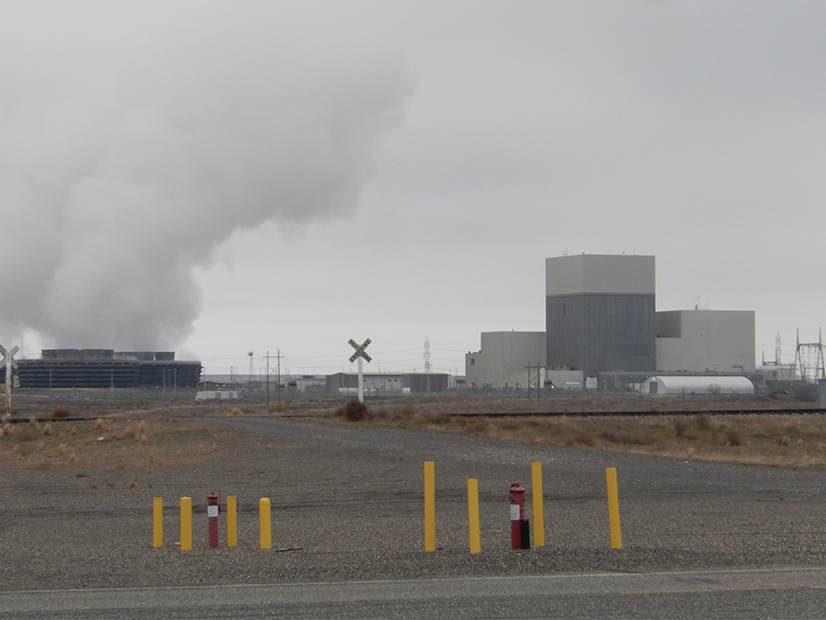Two new nuclear plants have been proposed as neighbors to the Pacific Northwest’s only existing commercial reactor on the Hanford Nuclear Reservation in Washington.
If approved, they would be the state’s first reactor projects since the Washington Public Power Supply System’s (WPPSS) reactor No. 2 went online in 1984. Plans are to have both complexes up and running by 2027.
Both projects share links with Energy Northwest, called WPPSS until a 1998 name change, after residents disparagingly referred to it as “Whoops” in response to the financial debacle associated with the system. At the same time, the 1,150-MW Washington Nuclear Project No. 2 (WNP-2) was renamed Columbia Generating Station (CGS). Energy Northwest owns the lands earmarked for the two proposed projects and would operate the reactors.
“They’re very different designs,” Greg Cullen, Energy Northwest’s vice president for energy services and development, told NetZero Insider.
In one project, four 80-MW modular reactors would be clumped together as a 320-MW complex on the site of the partly built WNP-1. These high-temperature gas-cooled reactors would be a joint venture by Energy Northwest, X-energy of Greenbelt, Md., (which would supply its Xe-100 design), and the Grant County Public Utility District (a potential investor and power customer).
“We really like their technology and their people,” Cullen said of X-energy.
The other project would be a 350-MW Natrium reactor, a sodium‐cooled fast reactor potentially built on the site of the WNP-4. This would be a joint venture between Energy Northwest and TerraPower, a Bellevue, Wash., reactor design developer founded by Bill Gates. Energy Northwest said it is in talks with the company about the project, but TerraPower said it has not yet settled on a site and is considering several locations.
The WNP-1 and WNP-4 sites already have basic infrastructures to support the construction of nuclear reactors.
Both sites are within a short distance of CGS. WPPSS tried to build five reactors in the 1960s and 1970s — three at Hanford and two in Satsop, Wash., but only WNP-2 was finished. The others were never completed because cost overruns and massive delays led to WPPSS in 1982 suffering the biggest bond default in Wall Street history up to that point. CGS went online in 1984 and is the only working commercial reactor in the Northwest.
Residential Divide
The genesis of the new projects goes back to last October when the U.S. Department of Energy awarded $80 million each to TerraPower and X-energy to design and build new advanced power reactors. DOE calculated that the two projects would together cost $6.4 billion. Congress has agreed to fund half the price tag through 2027 with TerraPower and X-Energy having to raise the rest. An X-energy press release from March 1 puts its project’s cost at $2.5 billion.
One question mark will be how Washington residents and politicians will react to building two new reactors in the state.
Gov. Jay Inslee has picked combating global warming as his top issue, and nuclear power has been frequently cited as a carbon-free alternative to fossil-fuel power plants. Besides CGS, the bulk of Washington’s power comes from a huge network of hydroelectric dams. The state will phase out its last coal-fired power plant by the middle of this decade.
Cullen said the two projects “meet the clean energy definition” of the CLEAN Future Act, introduced in the U.S. House in January to reduce U.S. carbon emissions to 50% from 2005 levels by 2030 and achieve net-zero emissions by 2050. The controversial bill is sponsored by House Energy and Commerce Committee Chairman Rep. Frank Pallone, Jr. (D-NJ), Environment and Climate Change Subcommittee Chairman Rep. Paul Tonko (D-NY) and Energy Subcommittee Chairman Rep. Bobby Rush (D-IL). (See Battle Lines Drawn over CLEAN Future Act.)
The state’s residents have traditionally been split on nuclear reactors. Residents of the Puget Sound area traditionally oppose any type of nuclear power. However, the Tri-Cities, home to Hanford and developed during World War II and the Cold War to build and operate plutonium-producing reactors, has always been strongly pro-nuclear. Since Hanford’s last plutonium reactor shut down in the late 1980s, Tri-Citians have unsuccessfully tried to revive a reactor-oriented industry for the past 30 years
In more recent years, Tri-Cities business interests have been pursuing setting up a modular reactor industry.
Small modular reactors are prefabricated facilities with parts manufactured in one location, then transported to the reactor site for final assembly. A modular segment would consist of a mini reactor of 50 to 300 MW. The design allows for extra modules to be added as needed.
Critics have cited the lack of any track record on cost or safety for small modular reactors, plus concerns over the nation’s lack of a permanent storage location for spent nuclear fuel.
Reactors nationwide have had trouble competing financially with natural gas as a source of electricity, leading to several plants being closed.
X-energy did not respond to a request for comment and TerraPower declined to comment. In an email, Grant County PUD said it is currently analyzing X-energy’s project and hopes to have a better grasp of its feasibility by the end of this year.
“We all like the small modular reactor concept, but would it be cost-effective? … The real issue is what does it cost. The price of renewables has dropped dramatically,” energy economist Robert McCullough said.
Nuclear power costs roughly $60-$80/MWh, compared with $30/MWh for renewables such as wind and solar, he said.
On the other hand, reactors are usually online about 80% of the time, while weather-sensitive renewable sources perform only 30 to 40% of the time, he said. “The average nuclear plant is more reliable than the average windmill.”
Because small reactors are less complicated than huge 1,000-MW reactors, they tend to be more reliable, McCullough said. “Big nukes are simply a bear to keep running.”



